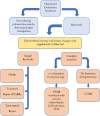Laparoscopic ventral mesh rectopexy vs. transperineal mesh repair for obstructed defecation syndrome associated with rectocele: comparison of selectively distributed patients
- PMID: 38001430
- PMCID: PMC10675873
- DOI: 10.1186/s12893-023-02206-0
Laparoscopic ventral mesh rectopexy vs. transperineal mesh repair for obstructed defecation syndrome associated with rectocele: comparison of selectively distributed patients
Abstract
Purpose: Obstructed defecation syndrome represents 50-60% of patients with symptoms of constipation. We aimed to compare the two frequently performed surgical methods, laparoscopic ventral mesh rectopexy and transperineal mesh repair, for this condition in terms of functional and surgical outcomes.
Methods: This study is a retrospective review of 131 female patients who were diagnosed with obstructed defecation syndrome, attributed to rectocele with or without rectal intussusception, enterocele, hysterocele or cystocele, and who underwent either laparoscopic ventral mesh rectopexy or transperineal mesh repair. Patients were evaluated for surgical outcomes based on the operative time, the length of hospital stay, operative complications, using prospectively designed charts. Functional outcome was assessed by using the Initial Measurement of Patient-Reported Pelvic Floor Complaints Tool.
Results: Fifty-one patients diagnosed with complex rectocele underwent laparoscopic ventral mesh rectopexy, and 80 patients diagnosed with simple rectocele underwent transperineal mesh repair. Mean age was found to be 50.35 ± 13.51 years, and mean parity 2.14 ± 1.47. Obstructed defecation symptoms significantly improved in both study groups, as measured by the Colorectal Anal Distress Inventory, Constipation Severity Instrument and Patient Assessment of Constipation-Symptoms scores. Minor postoperative complications including wound dehiscence (n = 3) and wound infection (n = 2) occurred in the transperineal mesh repair group.
Conclusion: Laparoscopic ventral mesh rectopexy and transperineal mesh repair are efficient and comparable techniques in terms of improvement in constipation symptoms related to obstructed defecation syndrome. A selective distribution of patients with or without multicompartmental prolapse to one of the treatment arms might be the preferred strategy.
Keywords: Initial Measurement of Patient-Reported Pelvic Floor Complaints Tool; Laparoscopic ventral mesh rectopexy; Obstructed defecation syndrome; Transperineal mesh repair.
© 2023. The Author(s).
Conflict of interest statement
The authors declare no competing interests.
Figures


Similar articles
-
Laparoscopic ventral rectopexy for obstructed defecation syndrome.Surg Endosc. 2008 Dec;22(12):2728-32. doi: 10.1007/s00464-008-9771-9. Epub 2008 Mar 5. Surg Endosc. 2008. PMID: 18320283
-
Laparoscopic ventral rectopexy using biologic mesh for the treatment of obstructed defaecation syndrome and/or faecal incontinence in patients with internal rectal prolapse: a critical appraisal of the first 100 cases.Tech Coloproctol. 2015 Apr;19(4):209-19. doi: 10.1007/s10151-014-1255-4. Epub 2015 Jan 11. Tech Coloproctol. 2015. PMID: 25577276
-
Short-term outcomes of laparoscopic ventral rectopexy for obstructed defecation in patients with overt pelvic structural abnormalities-a Chinese pilot study.Int J Colorectal Dis. 2017 Sep;32(9):1337-1340. doi: 10.1007/s00384-017-2815-7. Epub 2017 Apr 13. Int J Colorectal Dis. 2017. PMID: 28409269
-
Current status of laparoscopic and robotic ventral mesh rectopexy for external and internal rectal prolapse.World J Gastroenterol. 2016 Jun 7;22(21):4977-87. doi: 10.3748/wjg.v22.i21.4977. World J Gastroenterol. 2016. PMID: 27275090 Free PMC article. Review.
-
Functional results after surgery for obstructed defecation.Acta Chir Iugosl. 2012;59(2):25-9. doi: 10.2298/aci1202025x. Acta Chir Iugosl. 2012. PMID: 23373355 Review.
Cited by
-
Obstructed Defecation Syndrome: Analysis of the Efficacy and Mid-Term Quality of Life of an Innovative Robotic Approach.Healthcare (Basel). 2024 Oct 4;12(19):1978. doi: 10.3390/healthcare12191978. Healthcare (Basel). 2024. PMID: 39408158 Free PMC article.
References
MeSH terms
LinkOut - more resources
Full Text Sources
Medical

